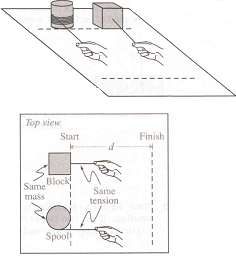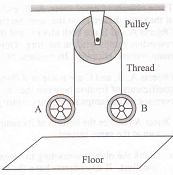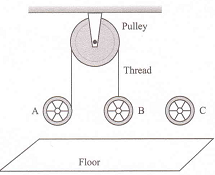Reference no: EM13867469
Problem 1. Energy analysis of the block-and-spool problem
A block and a spool are each pulled across a level, frictionless surface by a string, as illustrated at right.
The string pulling the block is tied to a small hook at the center of the front face of the block (not shown). The string pulling the spool is wrapped many times around the spool and may unwind as it is pulled.
The block and the spool have the same mass. The strings are pulled with the same constant tension and start pulling at the same instant.
Make the approximation that the strings and the hook are massless.

a. Does the spool cross the finish line before, after, or at the same instant as the block? Explain.
b. Consider the following dialogue between two students:
Student I: 'I think that there's the some amount of work done on block and spool as they are pulled from the start to the finish since they both move the same distance.'
Student 2: 'I disagree. I think that the hand pulling the spool does more work than the hand pulling the block since the string unwinds as the spool is pulled."
With which student, if either, do you agree? Explain.
c. When each crosses the finish line, is the total kinetic energy of the spool greater than, less than, or equal to that of the block? Explain. (Hint: Use the work-energy theorem.)
d. When each crosses the finish line, is the translational kinetic energy of the spool greater than, less than, or equal to that of the block? Explain.
Problem 2. Three identical rectangular blocks are at rest on a level, frictionless surface. Forces of equal magnitude that act in the same direction are exerted on each of the three blocks. Each force is exerted at a different point on the block (indicated by the symbol "x"), as shown in the top-view diagram below. The location of each block's center of mass is indicated by a small circle.

a. For each of the blocks, draw an arrow on the diagram above to indicate the direction of the acceleration of the block's center of mass at the instant shown. If the magnitude of the acceleration of the center of mass of any block is zero, state that explicitly. Explain.
b. Rank the blocks according to magnitude of center-of-mass acceleration, from largest to smallest. If any two blocks have the same magnitude center-of-mass acceleration, state so explicitly. Support your ranking by drawing a point free-body diagram for each block.
Problem 3. A uniform rigid rod rests on a level, frictionless surface. The diagram below indicates four different combinations of (I) net force on the rod and (2) net torque on the rod about its center of mass. In each box, draw vectors that represent one or two forces that achieve the given combination of net force and net torque. If any combination is not possible, state so explicitly.
For example: In the second case, indicate one or two forces that could be exerted on the rod so that at the instant shown the net force on it is zero, but the net torque on it is not zero.
Problem 4. Three objects of equal mass, A, B, and C, are released from rest at the same instant from the same height on identical ramps. Objects A and B are both blocks, and they slide down their respective ramps without rotating. Object C rolls down the ramp without slipping. Its moment of inertia is unknown.

Objects A, B, and C are made of different materials, thus the coefficients of friction between the objects and their corresponding ramps are not necessarily the same.
Object A reaches the bottom of its ramp first, followed by objects 13 and C, which reach the bottom at the same instant.
a. Rank the objects according to magnitude of center-of-mass acceleration, from largest to smallest. If any objects have the same magnitude center-of-mass acceleration, state so explicitly. Explain.
b. Rank the net forces exerted on the three objects according to magnitude, from largest to smallest. If the net force on any two objects is the same, state so explicitly. Explain.
c. In the spaces provided, draw and label a (point) free-body diagram for each object.
d. Rank the frictional forces exerted on the three objects according to magnitude, from largest to smallest. If the magnitude of the frictional force is the same on any two objects, state so explicitly. Explain your reasoning.
Problem 5. Energy analysis of falling-spools experiment
The modified Atwood's machine shown at right consists of two identical spools connected by a massless, inextensible thread that runs over an ideal pulley. The thread is wrapped around spool A many times, but it is attached to a fixed point on spool B, so that spool B will not rotate.

The spools are released from rest from the same height at the same instant.
a. In tutorial, you observed the motion of the spools after they were released. Ignoring small differences Floor in their motions:
• In which direction did each spool move?
• Did spool A hit the ground before, after, or at the same instant as spool B?
b. Is the magnitude of the center-of-mass acceleration of spool A (while it is falling) greater than, less than, or equal to that of spool B? Explain.
c. Is the translational kinetic energy of spool A just before it hits the ground greater than, less than, or equal to that of spool B? Explain.
d. Is the total kinetic energy of spool A just before it hits the ground greater than, less than, or equal to that of spool B? Explain.
e. Consider the system consisting of all of these objects: spool A, spool B, the thread, the pulley, and the Earth.
i. Explain how you can tell that the total energy of this system (i.e. Ugrav,A + Ugrav,B + Ktrans,A + Ktrans,B + KrotA + Krot, B) is constant as spools A and B fall.
ii. Suppose that this system starts with Ugrav,A = Ugrav,B = 9J. Just before the spools hit the ground, which is where the zero for gravitational potential energy is chosen, spool A has translational kinetic energy Ktrans,A= 4J. Determine the value of the rotational kinetic energy of spool A at this instant. Show your work.
Problem 6. A third identical spool, spool C, is added to the falling-spools experiment described in the preceding problem.
As above, all spools are released from rest from the same height at the same instant. Spool C is not in contact with any other objects as it falls.

a. Rank the spools according to magnitude A of center-of-mass acceleration (while falling), from largest to smallest. If any spools have the same center-of-mass acceleration, state so explicitly. Explain.
b. As in the preceding problem, suppose that Ugrav,A = Ugrav,B = 9J before the spools are released. Just before the spools hit the ground, which is where the zero for gravitational potential energy is chosen, spool A has translational kinetic energy Ktrans,A = 4J.
i. Rank the spools according to maximum translational kinetic energy, from largest to smallest. If any spools have the same maximum translational kinetic energy, state so explicitly. Explain.
ii. Rank the spools according to maximum total kinetic energy, from largest to smallest. If any spools have the same maximum total kinetic energy, state so explicitly. Explain.